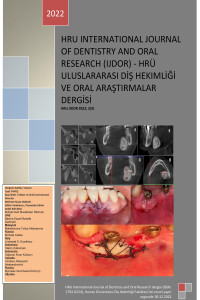Abstract
Adenoid yüz 1872 yılında C.S. Tomes tarafından tanımlanmış, havayolu obstrüksiyonu sonucunda dentofasiyal bölgede meydana gelen bir yüz formudur. Solunum şeklinin kraniyofasiyal büyüme üzerindeki etkisi, yıllardır diş hekimliği alanında geniş çapta tartışılan ve çözüm aranan bir konu olmuştur. Genel olarak hipertrofik adenoidler nedeniyle, nazal solunumun obstrükte olarak ağız solunumuna ve adenoid yüz stereotipine yol açtığı ileri sürülmüştür. Bu hipotez yıllar içerisinde yapılan çalışmalarla birlikte artık kesinlik kazanmıştır. Adenoid yüz yetişkin bireylerde de görülmesine karşın en çok büyüme gelişme çağındaki çocuklarda görülmektedir. Bu nedenle çocuk doktorlarının, kulak burun boğaz uzmanlarının, çocuk diş hekimlerinin ve ortodontistlerin, adenoid yüzün klinik ve radyografik bulgularına hakim olup, doğru teşhis yapmaları önem taşımaktadır. Dental muayeneye gelen çocuklarda çok belirgin olarak kendini gösteren bu durum genellikle gözden kaçmakta ve gerekli önlemler alınamamaktadır. Çene yüz gelişimi ve dişlerin pozisyonlarını etkileyerek anomalilere sebep olabilmekte ve ilerleyen dönemlerde daha komplike sorunlara yol açabilmektedir. Tüm bu sebebplerden dolayı adenoid yüz formasyonunu iyi bilmek ve yapılacak müdahale ya da yönlendirmelere hakim olmak oldukça önemlidir. Bu derlemede adenoid yüz formunun etiyolojisi, tanı ve teşhis yöntemleri, tedavi seçenekleri detaylı incelenmiştir ve diş hekimlerinin adenoid yüze sebep olabilecek faktörlerin tanısında, dentofasiyal bozuklukların engellenmesi veya düzeltilmesinde ve kulak burun boğaz bölümüne sevkinde kilit noktayı oluşturdukları sonucuna varılmıştır.
References
- 1. Brady MF, Burns B. Airway obstruction. Top Emerg Med. 2021;2(1):15-29. doi:10.1016/b978-0-323-05674-8.50157-2
- 2. Geiger Z, Gupta N. Adenoid hypertrophy. Case Based Reviews in Pediatric Pulmonology. 2021:30-30. doi:10.5005/jp/books/13112_7
- 3. Pereira, Lara et al. “Prevalence of adenoid hypertrophy: A systematic review and meta-analysis.” Sleep medicine reviews vol. 38 (2018): 101-112. doi:10.1016/j.smrv.2017.06.001
- 4. İnönü-Sakalli N, Sakalli C, Tosun Ö, Akşit-Biçak D. Comparative evaluation of the effects of adenotonsillar hypertrophy on oral health in children. Biomed Res Int. 2021;2021. doi:10.1155/2021/5550267
- 5. Tomes CS. On the developmental origin of the v-shaped contracted maxilla. Monthly Revue of Dental Surgery. 1872;1:2-5.
- 6. Li, Huina et al. “Influences of Airway Obstruction Caused by Adenoid Hypertrophy on Growth and Development of Craniomaxillofacial Structure and Respiratory Function in Children.” Computational and mathematical methods in medicine vol. 2022 5096406. 30 Aug. 2022, doi:10.1155/2022/5096406
- 7. Masters KG, Zezoff D, Lasrado S. Anatomy, head and neck, tonsils. StatPearls. Published online July 25, 2021. https://www.ncbi.nlm.nih.gov/books/NBK539792/
- 8. Chasan T, Akçam O. Adenoid vejetasyon ve ortodonti. European Annals of Dental Sciences. 2013;40(3):139-147.
- 9. Walker HK, Hall WD, Hurst JW. Clinical methods. Geriatric Psychiatry. Published online 1990:77-121. https://www.ncbi.nlm.nih.gov/books/NBK201/
- 10. Mnatsakanian A, Heil JR, Sharma S. Anatomy, head and neck, adenoids. StatPearls. Published online July 26, 2021. https://www.ncbi.nlm.nih.gov/books/NBK538137/
Abstract
Adenoid face was defined in 1872 by C.S. Tomes, is a facial form that occurs in the dentofacial region because of airway obstruction. The effect of breathing patterns on craniofacial growth has been a widely discussed and sought-after issue in dentistry for years. It has been suggested that nasal breathing is obstructed, generally due to hypertrophic adenoids, leading to mouth breathing and adenoid face stereotype. This hypothesis has now become definite with the
studies carried out over the years. Although adenoid face can also be seen in adults, it is mostly seen in children in the growth and developmental age. For this reason, it is important for pediatricians, otolaryngologists, pediatric dentists, and orthodontists to have good knowledge about the clinical and radiographic findings of the adenoid face to make an accurate diagnosis. This situation, which manifests itself very clearly in children who come for a dental examination, is often overlooked and necessary precautions cannot be taken. It can cause anomalies by affecting the dentofacial development and the positions of the teeth and may lead to more complicated problems in the future. For all these reasons, it is very important to know the adenoid face formation well and to have a good command of the interventions or directions. In this review, the etiology, diagnosis and diagnosis methods, and treatment options of the adenoid face form were examined in detail, and it was concluded that dentists constitute the key point in the diagnosis of factors that may cause adenoid face, prevention, or correction of dentofacial disorders, and referral to the otolaryngology department.
References
- 1. Brady MF, Burns B. Airway obstruction. Top Emerg Med. 2021;2(1):15-29. doi:10.1016/b978-0-323-05674-8.50157-2
- 2. Geiger Z, Gupta N. Adenoid hypertrophy. Case Based Reviews in Pediatric Pulmonology. 2021:30-30. doi:10.5005/jp/books/13112_7
- 3. Pereira, Lara et al. “Prevalence of adenoid hypertrophy: A systematic review and meta-analysis.” Sleep medicine reviews vol. 38 (2018): 101-112. doi:10.1016/j.smrv.2017.06.001
- 4. İnönü-Sakalli N, Sakalli C, Tosun Ö, Akşit-Biçak D. Comparative evaluation of the effects of adenotonsillar hypertrophy on oral health in children. Biomed Res Int. 2021;2021. doi:10.1155/2021/5550267
- 5. Tomes CS. On the developmental origin of the v-shaped contracted maxilla. Monthly Revue of Dental Surgery. 1872;1:2-5.
- 6. Li, Huina et al. “Influences of Airway Obstruction Caused by Adenoid Hypertrophy on Growth and Development of Craniomaxillofacial Structure and Respiratory Function in Children.” Computational and mathematical methods in medicine vol. 2022 5096406. 30 Aug. 2022, doi:10.1155/2022/5096406
- 7. Masters KG, Zezoff D, Lasrado S. Anatomy, head and neck, tonsils. StatPearls. Published online July 25, 2021. https://www.ncbi.nlm.nih.gov/books/NBK539792/
- 8. Chasan T, Akçam O. Adenoid vejetasyon ve ortodonti. European Annals of Dental Sciences. 2013;40(3):139-147.
- 9. Walker HK, Hall WD, Hurst JW. Clinical methods. Geriatric Psychiatry. Published online 1990:77-121. https://www.ncbi.nlm.nih.gov/books/NBK201/
- 10. Mnatsakanian A, Heil JR, Sharma S. Anatomy, head and neck, adenoids. StatPearls. Published online July 26, 2021. https://www.ncbi.nlm.nih.gov/books/NBK538137/
Details
| Primary Language | Turkish |
|---|---|
| Subjects | Dentistry |
| Journal Section | Reviews |
| Authors | |
| Publication Date | December 30, 2022 |
| Published in Issue | Year 2022 Volume: 2 Issue: 3 |


